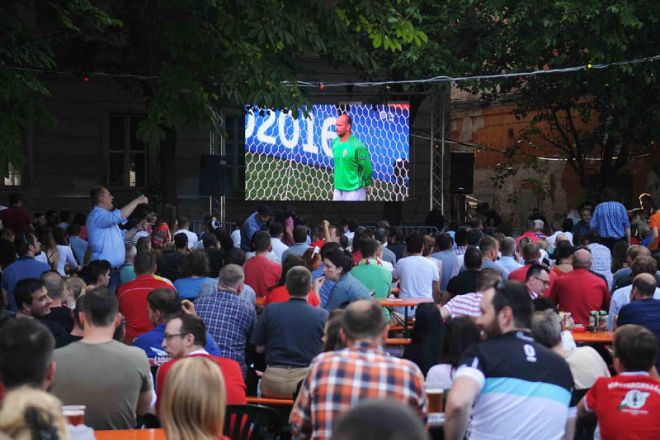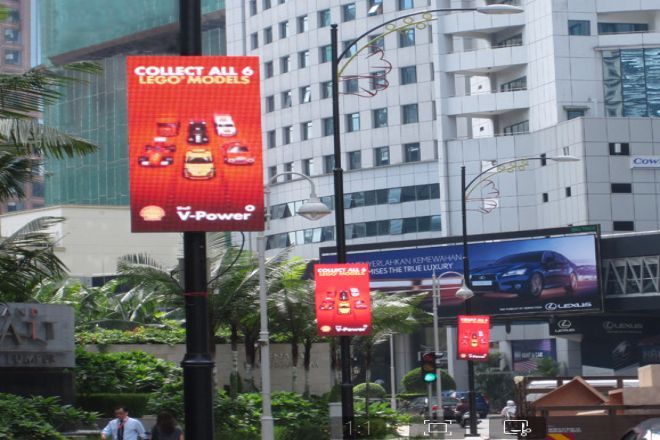Introduction

In the ever-changing technological wave, Écrans d'affichage LED have gradually become an indispensable part of modern communities with their excellent display effects, flexible application scenarios, and efficient energy utilization.
They are not only a window for information transmission but also a vivid embodiment of the integration of community culture, residents’ lives, and technological progress. From the first ray of sunshine in the morning to the bright stars at night, LED display screens light up every corner of the community with their unique charm, allowing residents to feel the convenience and beauty brought by technology in their daily lives.
With the continuous deepening of smart community construction, it is particularly important to choose the right type of LED display screen. It not only meets the diverse information display needs of the community but also coexists harmoniously with the overall environment of the community, becoming an important element to enhance the image of the community and enhance the sense of belonging of residents.
1. Community demand analysis
Before deciding to install an LED display screen for the community, an in-depth and detailed demand analysis is an indispensable step. This not only helps to ensure that the selected display screen type is in line with the actual needs of the community but also maximizes the investment benefits and improves residents’ satisfaction. The following are the key aspects of community demand analysis:
1). Purpose positioning
- Communiqué d'information :
LED display screens should become an important channel for community information communication. It can publish key information, such as community announcements, weather forecasts, emergency notices, etc., in real time to ensure that residents can understand and prepare accordingly. This immediacy and wide coverage are difficult to match with traditional bulletin boards.
- Cultural publicity:
As a display window for community culture, LED display screens can vividly present community activities, festivals and celebrations, residents’ demeanor, and other content and enhance community cohesion and sense of belonging. Through dynamic pictures and sound effects, residents can feel the vitality and harmony of the community both visually and auditorily.
- Commercial promotion (if allowed):
Without affecting the overall atmosphere of the community, LED display screens can also be used to display advertising information on surrounding businesses.
This can not only provide an effective publicity platform for businesses but also bring certain economic benefits to the community, achieving a win-win situation.
However, attention should be paid to the screening of advertising content and the reasonable arrangement of broadcast time to avoid interference with residents’ lives.
- Environmental beautification:
The night lighting effect of LED display screens is often impressive. By combining night scene lighting design, LED display screens can become one of the highlights of the community night scene, enhancing the overall image and quality of the community.
At the same time, it can also create a strong atmosphere during special festivals or celebrations, enhancing the residents’ festival experience.
2). Location considerations
- Entrance/exit:
These areas are the only way for residents to enter and exit the community, so installing LED screens can ensure that information is disseminated most widely. At the same time, it also facilitates residents’ quick obtaining of the required information when entering and exiting, improving life efficiency.
- Public activity areas:
Areas such as squares and parks are important places for residents to relax, entertain, and socialize. Installing LED screens in these places can attract more people to gather and watch, enhancing the attractiveness and participation of community activities.
In addition, it can also serve as a background board or stage for community activities to enhance the overall effect of the activities.
- Building exterior wall:
Installing LED screens on the exterior walls of community buildings can make it one of the landmark buildings of the community. This not only helps to improve the recognition and popularity of the community but also visually forms a unique landscape and enhances the overall beauty of the community.
3). Budget planning
Budget is one of the important factors in determining the selection of LED screens. Communities should set a reasonable budget range based on their own size, economic strength, and expected results.
In the budget formulation process, it is necessary to consider factors such as the purchase cost, installation cost, operating cost, and maintenance cost of the display screen fully to ensure that the investment can produce good economic and social benefits. At the same time, we should also avoid blindly pursuing high-end configurations while ignoring actual needs.
2. Overview of LED display screen types

When choosing an LED display screen suitable for the community, it is crucial to understand the characteristics of different types of displays and their applicable scope. The following is an overview of several common LED display screen types and their characteristics:
1). Indoor fixed-mount LED display screen
Features: Designed for indoor environments, with high definition and rich color expression, it can present delicate and realistic images and videos. Emphasize close-up viewing experience to ensure the accuracy of information transmission and optimization of visual effects.
Applicable scenarios: Indoor places such as community service centers, conference rooms, and activity rooms. These areas have high requirements for display effects and viewing experience, and indoor fixed-mount LED displays can meet these needs.
Installation method: Flexible and diverse, including wall-mounted, hanging, etc., which can be selected according to the actual installation environment and needs.
2). Outdoor waterproof LED display screen
Features: Designed for outdoor environments, it has excellent waterproof and dustproof performance and can withstand erosion from harsh weather conditions. The high-brightness design ensures that the content can be clearly displayed even under direct sunlight and is not affected by ambient light.
Applicable scenarios: Outdoor areas such as community entrances, squares, and parks. These areas have a large flow of people, high demand for information displays, and are often affected by weather changes, so outdoor waterproof LED displays are an ideal choice.
Advantages: Not only does it meet the needs of information transmission, but it can also serve as a beautiful landscape in the community and enhance the overall image.
3). Flexible, bendable LED display
Features: It has unique bendability and can adapt to various irregular or curved installation environments. Its creativity and flexibility give it a significant advantage in creating unique community landscapes or art installations.
Applicable scenarios: It is suitable for installation on the surface of buildings with special shapes or structures, next to sculptures, or as a decorative element. Flexible bendable LED displays can add a unique artistic atmosphere and modern feel to the community.
Creative application: Through creative design and layout, impressive visual effects and interactive experiences can be created.
4). Transparent screen LED display.
Features: Maintaining a certain degree of light transmittance, it can display information without affecting indoor lighting. Its unique transparent effect makes it blend into the surrounding environment, which is both beautiful and practical.
Applicable scenarios: Communities near commercial blocks and shopping centers, as well as places where indoor lighting and transparency need to be maintained. Transparent LED display screens can effectively convey information in these environments without destroying the original architectural style and visual effects.
Advantages: It not only meets the needs of information display but also retains the transparency and lighting of the indoor space. It is an increasingly popular type of display screen in modern urban communities.
3. Key factors in selection
When choosing an LED display screen suitable for a community, it is necessary to comprehensively consider multiple key factors to ensure that the selected display screen can meet the actual needs of the community and bring long-term benefits. The following are several aspects that need to be focused on during the selection process:
1). Effet d'affichage
Resolution: High-resolution display screens can present more delicate and clear images and videos, improving the viewing experience.
Brightness: Select the appropriate brightness level according to the installation environment. For outdoor display screens, high brightness is the key to ensure clear display even under direct sunlight.
Contrast: High contrast helps to enhance the layering of the picture and make the image more vivid and vivid.
Color saturation: Rich color expression can present a more realistic and bright picture and enhance the visual impact.
2). Durability
Material: Choose a display screen made of high-quality materials, such as corrosion-resistant and wear-resistant shells and high-quality LED chips to ensure the service life and stability of the display screen.
Protection level: Choose a display screen with a corresponding protection level according to the installation environment. For example, a display screen with an IP65 level or above can resist the damage of external factors such as water and dust.
Maintenance convenience: Consider the modular design of the display screen and the easy replacement of vulnerable parts so that they can be quickly repaired and restored for use in case of failure.
3). Energy consumption and cost
Energy consumption: Choose energy-efficient LED display screen products to reduce long-term operating costs. Pay attention to parameters such as the product’s energy efficiency ratio and power consumption.
Cost: Consider the purchase cost, installation cost, operating cost, and later maintenance cost of the display screen, formulate a reasonable budget, and choose a cost-effective product.
4). Installation and maintenance
Installation convenience: Choose a display screen product that is easy to install and debug to reduce the time and labor costs during the installation process.
Maintenance convenience: Consider the maintenance needs and cycles of the display screen, and choose intelligent products with remote monitoring, fault diagnosis, and other functions to detect and solve problems in a timely manner.
5). Intelligent control
Remote control: Display screens that support remote control can facilitate managers’ control and management of the display screen at any location, improving work efficiency.
Real-time content update: Display screens with real-time content update functions can ensure the timeliness and accuracy of information and meet the community’s high requirements for information communication.
Intelligent management: Consider whether the display screen supports intelligent management systems, such as automatic brightness adjustment, timed power on and off, etc., to further reduce energy consumption and labor costs.
4. Summary and suggestions

In the process of exploring the selection and deployment of community LED display screens, we deeply analyzed the actual needs of the community, the characteristics of different types of display screens, and the key factors of selection. Through this series of discussions, we can draw the following small suggestions:
- Comprehensive consideration, scientific selection:
When choosing an LED display screen, the community should fully consider the community’s purpose positioning, installation location, budget planning, and other factors, comprehensively evaluate the advantages and disadvantages of different types of display screens, and choose the type of display screen that best suits the actual needs of the community.
- Focus on quality and take into account benefits:
Product quality is the key to ensuring the long-term and stable operation of the display screen. Therefore, in the selection process, we should focus on the core indicators of the display screen, such as display effect, durability, energy consumption, and cost, and consider the after-sales service guarantee of the product to ensure the maximum return on investment.
- Intelligent management improves efficiency:
With the development of science and technology, intelligence has become an important trend in the LED display industry. Communities should prioritize the display of screen products that support remote control, real-time content updates, and other intelligent functions to improve management efficiency and reduce operating costs.
Conclusion
In summary, choosing the right type of LED display screen is of great significance to the construction and development of modern communities.
It not only affects the efficiency and effectiveness of information transmission but also directly affects the quality of life of community residents and the overall image of the community. Therefore, in the decision-making process, we should fully consider the actual needs of the community, budget constraints, and long-term planning and strive.
Enfin, si vous souhaitez en savoir plus sur les écrans LED, veuillez nous contacter.
